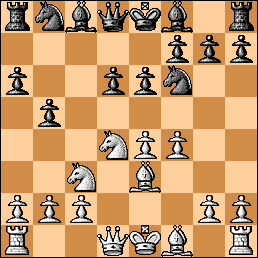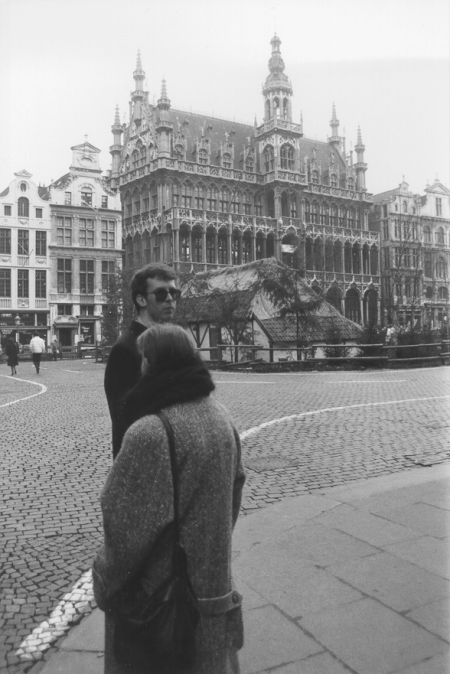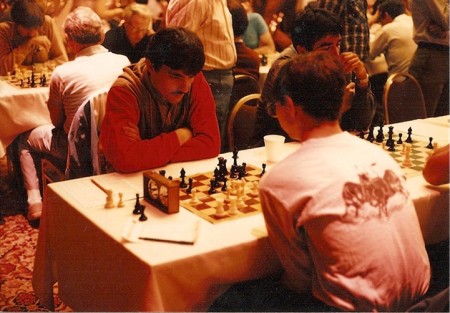In 1989 I played in the Manhattan Chess Club Championship at Carnegie Hall on West 57th Street in Manhattan. Although I won the 1988 and 1990 events, this 1989 version really escapes my memory, even when I look at the game scores.
Reader query: I cannot locate a list of the champions by year! I could only locate this somewhat anemic “history” of the MCC. Does anyone have access to such a list? See the bottom of this post for my highly incomplete reconstruction. Has the venerable club really fallen into such depths of paucity? Note on February 14th: Nick Conticello has risen to the occasion and is locating this list of champs 1883-1997 (originally compiled by Walter Shipman) – see comments.
3/14/08: Here’s Nick’s PDF file converted to an image: (click several times on the image to enlarge). I would like to see LOCATIONS too! (The MCC moves around a lot). Probably the MCC had some more champs after 1997, readers? (This list was compiled in 1997, but I don’t think the club was totally defunct yet).

MCC Champs 1883-1997. List compiled by IM Walter Shipman. Source: Nick Conticello.
In the third round I played New York personality Charlie Weldon. Charlie unfortunately died in 1993 while traveling in Yugoslavia (I believe of acute appendicitis) and here is his Wikipedia entry. I actually learned of his death by reading a clipping in the Village Chess Shop in Greenwich Village, NYC.
Charles Weldon (born 1939 in Milwaukee, Wisconsin – died of peritonitis in 1993 in Belgrade, Yugoslavia) was a chess master and professor of computer science at City University of New York.
Weldon was a three-time Wisconsin State Chess Champion, and swept all his games at the US Amateur Chess Championship. He is listed as a life member with the United States Chess Federation. He was known for playing the Schliemann Defense.
Now let’s see the game.
Charlie Weldon [2398] – IM Mark Ginsburg, Manhattan CC Champ. 1989, Round 3.
1. d4 Nf6 2. Nf3 g6 3. c4 Bg7 4. g3 O-O 5. Bg2 d6 6. O-O Nbd7 7. Nc3 a6!? I like this move, the poor man’s Panno (since the N is on d7, not c6). 8. e4 c5 9. h3 None other than future-WC Anatoly Karpov suffered a famous reverse, losing to Andras Adorjan, with 9. Re1 cxd4 10. Nxd4 Nc5 11. h3 Bd7 12. Be3 Rc8 13. Rc1 Qa5 14. a3 Na4 15. b4 Nxc3 16. Rxc3 Qa4 17. Qb1 Rc7 18. Rec1 Rfc8 19. Qd3 Be8 20. Bf3 Nd7 21. Bd1 Ne5 22. Qf1 Qd7 23. c5 b5 24. Bb3 dxc5 25. Rxc5 Rxc5 26. bxc5 Nc4 27. Bxc4 Bxd4 28. Rd1 e5 29. Bxd4 exd4 30. Bd5 Rxc5 31. Rxd4 Qc8 32. h4 Rc2 33. e5 Qc3 34. Rd3 Qxe5 35. Qg2 Kg7 36. Qf3 Qe1+ 37. Kg2 Rc1 38. g4 Qh1+ 39. Kg3 Rg1+ 40. Kf4 Qh2+ 41. Ke4 Qxh4 and white gave up, 0-1 Karpov,A-Adorjan,A/Hungary 1969. See the book “Black is OK!” by Adorjan for more details on that game. Also 9. e5 dxe5 10. dxe5 Ng4 11. e6 fxe6 12. Qe2 Nde5 gives a tiny edge at best.
9… cxd4 10. Nxd4 Nc5 11. Be3 Bd7 12. Qe2 Black is fine after 12. b4?! Ne6.
12…Rc8 Playable here is 12… Na4 13. Nxa4 Bxa4 14. Rac1 Rc8 15. b4 Bd7 and black went on to win a long maneuvering game, Cacho Reigadas,S (2200)-Garcia,A (2335)/Lleida 1991.
13. Rfd1 (0:23)

Position after 13. Rfd1: Black is OK!
13…Qa5?! The moves 13…h5 or 13…Qc7 are both more logical. The white move b2-b4 is not especially fearsome and does not have to be prevented. For example, 13…h5 14. b4 Na4! 15. Nxa4 Bxa4 or 13…Qc7 14. Rac1 Rfe8 15. b4 Na4 in both cases with a complicated game.
14. Rab1?! White had the strong 14. Nb3! here with a distinct edge.
14…Na4 (0:21) 15. Nxa4 Bxa4 16. b3 Bd7 17. a4 Rfd8 18. Qd2 Qc7 19. a5 Be8 20. Ne2 Qb8 21. Bb6 Rd7 22. f3 22. Nc3 is more natural.
22…e6 23. f4 (0:44) d5? (1:10) I don’t know what I was thinking, but this move simply does not work. I should just wait.
24. cxd5 exd5 25. e5? Why this? Although white keeps a small edge, he should grab the free pawn: 25. exd5 Bf8 26. Rbc1 and black has no compensation.
25… Ne4 (1:11) 26. Qe3 The strongest is 26. Qb2.
26… f5 27. exf6?! Another miscue. White should play 27. Rd3 Bf7 28. Nc3 Be6 29. Rbd1 and this is good for him.
27… Bxf6 28. Bd4 [0:48] Qd6 29. Rbc1 White can play for equality here with 29. Bxe4 dxe4 30. Kh2 Rf7 31. Nc3 Bxd4 32. Rxd4.
29… Rxc1 30. Rxc1 Re7 (1:31) 31. Bxf6 Qxf6

Position after 31…Qxf6: Tense Equilibrium
32. Qb6?? Charlie, rushing for no reason (only 60 minutes elapsed in a 40/2 game) blunders badly. The not very obvious 32. Nc3! Bc6 33. Nxe4 dxe4 34. Rd1 Kg7 is about equal. He should have taken time here and found that clever defense. 32. Bxe4 Rxe4 33. Qd2 is another “OK” line for white but it looks risky to give up the fianchettoed bishop.
32… Qb2! [1:48] White cannot handle this infiltration. Black wins in all lines.
33. Bf3 (1:05) The alternative 33. Qe3 is slightly tougher, but after 33…Bc6 34. Rf1 Qd2! 35. Rf3 Qxa5 black wins.
33… Nxg3! A standard overloading tactic. 34. Bxd5+ Kf8 35. Nxg3 Qxc1+ 36. Kg2 Qd2+ 0-1
My results so far:
Round 1- 1/2 pt. bye
Round 2 1-0 Larry Tamarkin
Round 3 1-0 Charlie Weldon
Round 4 1/2 B. Zuckerman
Now I will present
Round 5 (1/2 vs. Michael Rohde) and Round 6 (1-0 vs James Schuyler).
Author’s note 3/15/08: According the Nick Conticello’s champion list (see above), Michael Rohde won the 1989 event!
Round 5, MCC Ch. M. Ginsburg – GM M. Rohde (2540).
1. c4 e5 2. Nc3 Bb4 3. g3 Nf6 4. Bg2 O-O 5. e4 d6 6. Nge2 Be6 7. d3 c6 8. a3 Ba5 9. O-O h6 10. b4 Bb6 11. Bb2 Qd7 12. Rc1 Bh3 13. Na4 Bd8

Position after 13…Bd8: I have nothing and quickly get less.
14. Qd2 a5 15. c5 Bxg2 16. Kxg2 axb4 17. Qxb4 b5 18. Nb6 Bxb6 19. cxb6 c5 My play has made very little sense and black logically builds up a big positional edge. 20. Qb3 Qc6 21. f4 Nbd7 22. fxe5 dxe5 23. Nc3 Ra5 24. Nd1 Qxb6 25. Ne3 Qe6 26. Qc2 Ra4 27. Nf5 c4 28. dxc4 Rxc4 29. Qd3

Position after 29. Qd3: I am toast.
29…Nc5 Here, 29… Rfc8 is crushing. From here on out, black (perhaps out of tiredness) misses a bunch of wins and finally white manages to hold a rook ending.
30. Qd6 Rxc1 31. Rxc1 Nfxe4 32. Ne7+ Kh7 33. Qxe6 fxe6 34. Rc2 Nd3 35. Re2 Ng5 Here, a nice win is 35… Rf2+ 36. Rxf2 Nexf2 37. Bxe5 Nxe5 38. Kxf2 Nc4 39. Ke2 Nxa3 40. Kd3 Nc4 41. Kc3 Ne3 42. Kb4 Nf1 and white can resign.
36. h4 Nf3 37. Bc3 Nd4 38. Re3 Rf7 The clever tactic 38… Rf2+! 39. Kh3 Ne2! sets up a mate threat and wins: 40. Rxd3 h5 41. Rd1 Nxc3 42. Ra1 e4 and it’s all over.
39. Rxd3 Rxe7 40. h5 Rc7 It’s getting harder, but 40…Rd7 41. Re3 Rd5 42. Kf2 Nc2 43. Rxe5 Rxe5 44. Bxe5 Nxa3 45. Bc3 Nc4 seems to do the trick; black should win.
41. Bxd4 Rd7 42. Rb3 exd4 43. Rxb5 Kg8 The long variation 43… d3 44. Rb1 Rd5 45. Rd1 Rxh5 46. Rxd3 Ra5 47. Re3 e5 48. a4 Kg6 49. Re4 h5 50. Rc4 Kf5 should win.
44. Kf2 Kf7 45. a4 Rc7 Unless I am missing something in this long variation, 45… Kf6 46. a5 e5 47. a6 Ra7 48. Rb6+ Kf5 49. Rd6 Ke4 50. Ke2 Rc7 51. Kd2 Rf7 52. Ke2 Rf3 will win.
46. Kf3 Rc3+ 47. Ke4 d3 48. Ke3 Now it’s just a draw – a quite lucky escape.
47… Ra3 49. a5 g6 50. hxg6+ Kxg6 51. Re5 Kf6 52. Rh5 Kg6 53. Re5 Kf7 54. Rh5 Kg7 55. Re5 Kf7 1/2-1/2
Round 6.
IM M. Ginsburg – NM James Schuyler (2300). Nimzovich Defense
A historical curiosity: James’s last name used to be Levine, he changed it a little bit previous to this event.
1. d4 Nc6 2. Nf3 d6 3. e4 Nf6 4. Nc3 Bg4 5. Bb5 a6 6. Bxc6+ bxc6 7. h3 Bh5 8. Bg5

Position after 8. Bg5. A Theoretical Position in the Nimzovich Defense.
8…Rb8(!) Rather inferior is 8… Qb8?! 9. Qd3! Bxf3 (Black cannot grab 9… Qxb2 10. Rb1 Qa3 11. O-O e6 12. Rb7 Rc8 13. Qc4 Kd7 14. Na4! and wins) 10. Qxf3 e6 11. O-O Nd7 12. b3 h6 13. Bh4 Qb4 14. Rad1 Qa5 15. Rfe1 and white was much better and went on to win, 1-0, Yuri Balashov – J. Orzechowski, Wisla 1992.
9. Qe2?! Qc8? Black actually could have eaten on b2 here with the rook with unclear chances.
10. O-O-O e6 11. d5 Qb7 12. b3 Be7 13. g4! Bg6 14. dxe6 fxe6 15. e5! White just has a big edge now.

Position after 15. e5! – Smooth Sailing for White now.
15…dxe5 16. Nxe5 O-O 17. Nxg6 Ba3+ 18. Kb1 hxg6 19. Qxe6+ Kh7 20. Qc4 Qb4 21. Qxb4 Bxb4 22. Bxf6 Rxf6 23. Ne4 Rf4 24. Rd4 Kh6 25. Rg1 Be7 26. c3 c5 27. Rc4 Bh4 28. g5+ Bxg5 29. Rxg5 Rxe4 30. Rgxc5 This ending is hopeless, black could have resigned. 30…Rxc4 31. Rxc4 g5 32. Rxc7 Rf8 33. Rc6+ Kh5 34. Rxa6 Rxf2 35. c4 Kh4 36. Rg6 Rf5 37. Rxg7 Kxh3 38. Kb2 g4 39. b4 g3 40. c5 g2 41. c6 Rf2+ 42. Kb3 and black gave up. 1-0.
Postscript: on January 23, 2008, Larry Tamarkin sent me another game I had played in this event. My knights dance well in this game.
M. Ginsburg – NM L. Tamarkin MCC (Ch.) 1989, Queen’s Indian. Round 2.
1. d4 e6 2. c4 b6 3. Nf3 Bb7 4. Bf4 Bb4+ 5. Nbd2 Nf6 6. e3 O-O 7. Bd3 Re8 8. O-O Bf8?! 9. Qc2 d6 10. Bg5 h6 11. Bh7+ Kh8 12. Bxf6 Qxf6 13. Be4 c6 14. Qa4 Qe7 15. Rad1 f5 16. Bb1 g5 17. c5!

17. c5! – the knights need squares.
17…dxc5 18. Ne5 Qf6 19. f4 g4 20. Kh1 cxd4 21. exd4 Rd8 22. Rfe1 Bd6 23. Qb3 Na6 24. Ndc4 Bf8 25. Na5 Bc8 26. Naxc6 Rd5 27. Bd3 Nc7 28. Rc1 Rd6 29. Nd8! Converging on f7 with both knights.

Position after 29. Nd8! – Nimble knights.
29…Nd5 30. Nef7+ Kg7 31. Nxd6 Bxd6 32. Nxe6+! The knights really rampaged in this game. Now it’s just a material capturing bloodbath.
32…Bxe6 33. Bc4 Bxf4 34. Bxd5 Bxc1 35. Rxe6 Qf8 36. Bxa8 1-0
So I finished the event with 4.5/6. I must confess I have no memory of *any* of these games. And I don’t know who won the 1989 event, because I can’t find any club history pages!
Just for fun, I insert here a scanned image of a 1988 MCC bulletin, edited by stalwart Steve Immitt using what appears to be an old-fashioned typewriter. Maybe you can read it (click to enlarge) well enough to play over an entertaining game between NM Ernest Colding and Michael Rohde, with notes by peripatetic NM Larry Tamarkin.

An MCC ’88 Bulletin: The Good Old Days of Carnegie Hall!
Help Needed – Fill in the History!
Over the years, the Manhattan CC saw many famous players. Bobby Fischer, Robert Byrne, Pal Benko, Bernard Zuckerman, Joel Benjamin, Kamran Shirazi, and many, many others. Does anyone have a list of the champions? I know the club opened in 1877 and closed in 2002 (there was no Championship in 2002; I don’t know if there was one in 2001 or 2000). Below I list the years, the champion’s name (if known), and the club location in that year. Can someone fill in the extensive gaps? Thanks in advance.
Year Champion Club Location
1877
1878
1879
1880
1881
1882
1883
1884
1885
1886
1887
1888
1889
1890
1891
1892
1893
1894
1895
1896
1897
1898
1899
1900
1901
1902
1903
1904
1905
1906
1907
1908
1909
1910
1911
1912
1913
1914
1915
1916
1917
1918
1919
1920
1921
1922
1923
1924
1925
1926
1927
1928
1929
1930
1931
1932
1933
1934
1935
1936
1937
1938
1939
1940
1941
1942
1943
1944
1945
1946
1947
1948
1949 Arthur Bisguier 100 Central Park South
1950
1951
1952
1953
1954
1955
1956
1957
1958
1959
1960
1961
1962
1963
1964
1965
1966
1967
1968
1969
1970
1971
1972
1973
1974
1975
1976
1977
1978
1979
1980
1981
1982 155 E 55th
1983 155 E 55th
1984 ** moved to 57th and 7th, 10th floor, from 155 E 55th **
1985
1986
1987
1988 Mark Ginsburg 57th and 7th Ave., Carnegie Hall, 10th floor
1989
1990 Mark Ginsburg 57th and 7th Ave., Carnegie Hall, 10th floor
1991
1992
1993
1994
1995
1996
1997
1998 Joel Benjamin
1999 Joel Benjamin
2000 Eric Cooke
2001
"2001 is a bit unclear in my memory. I know Leonid Yudasin beat Benjamin in a
two-game blitz playoff for some kind of trophy, but I can't say for sure Yudasin
was a member. However, consider the following points: 1) Manhattan CC record-keeping was so sloppy that Yudasin may indeed have been a member by the then
prevailing standard of filling out an application (for a GM.)
2) The event crosstable shows Yudasin in first place.
3) I addressed Joel as a "six-time Manhattan CC Champion" at the Bruce Bowyer memorial
yesterday and he did not correct me.
A possible countervailing point is my January 2003 Chess Life piece,
which i can't find, and in which I may (possibly) have called Joel a seven-time champion.
So at this moment I am not quite sure." - Nick Conticello.
Postscript – The MCC Before Carnegie Hall
Larry Tamarkin told me (1/29/08) that the MCC was located on 55th street, on the East Side, and moved to Carnegie Hall around 1986. [?] Update February 2008: Randy Gunolo sends this comment in: “The Manhattan moved to Carnegie Hall in early 1984. Before that, it was at 155 E 55th, where Xaviera Hollander had had her offices in her glory days. I’m not sure if their paths briefly crossed or they just missed each other.” Author’s note: Dutch import Xaviera Hollander is the author of a best-selling book, The Happy Hooker.
Postscript 2: Bridge and Games East, aka ‘Sleaze East’
Larry Tamarkin also reminded me about Sleaze East (not the club’s real name). The club’s real name was “Bridge and Games East” – see comments section. This East Side gambling establishment featured Dzindzi playing long backgammon matches. It shut in the mid-80s, possibly 1985 (or a little later), when a disgruntled gambler fired a gun in the club. The police had to dig the bullet out with a tool. Larry was there and “he grapped me by the scruff of my neck and said that I didn’t seem to understand him when he was ‘telling’ everyone else to get out…”.
(Larry didn’t “understand” he wanted everyone to clear out when he fired the gun).
“He was mad at me cause i didn’t move out like everyone else when his gun was being fired…I was so in my little world i didn’t even know what was happening….I think he calmed down when he realized i wasn’t intentionally trying to ‘diss him’…he let me go and Steve Immitt later said I was lucky he didn’t shoot me!”
After this bullet episode, the club shut. Larry thinks it was on 57th and 2nd or 3rd avenue. The commentor, Mr. Randy Gunolo, opines it was on E 56th street. I will need help from the readers as to this club’s real name and more exact location and year of closing.
‘Crazy Joe’ and the 38-special at Sleaze East
This just in from Steve Immitt on the famous gun incident at Sleaze East: ” “Crazy Joe” let loose a couple of rounds from his .38, while you [Larry Tamarkin – ed.] and Larry Sanchez were busy playing speed chess and everyone else hit the deck.” I had visited Sleaze East a couple of times, and saw Dzindzi in a very long backgammon tussle. Rebekah Greenwald asked Roman in Russian, “kak tebya nravitsia eto…. Sleaze East”? (translated to “How do you like this…. Sleaze East?”). Roman stared at her and did not reply.
For Further Reading
Visit this other blog entry [4/28/08] for Nick Conticello presenting an abridged MCC timeline.
























































